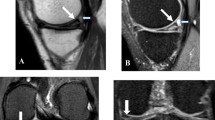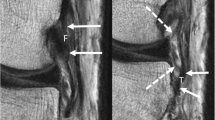Abstract
Purpose
To compare the performance of 3D-FSE-Cube MRI to arthroscopy, the reference test for the diagnosis of partial anterior cruciate ligament (ACL) tears.
Methods
A retrospective study was performed including all patients who underwent surgery for an ACL tear in our Sports Surgery Unit from January 2008 to December 2009. All patients underwent a preoperative MRI, conventional 2D or 3D-Cube. The diagnosis of a partial tear was based on the appearance of the ligament bundles and signal quality on MRI, and on the continuity of the fibers on arthroscopy and the quality of the remaining ligament. Sixty-four of the 312 included patients underwent MRI 3D-Cube and 248 conventional 2D-MRI. The series included 82 women and 223 men, mean age 33.3 ± 19.6 years. Arthroscopy did not reveal any normal ACL, 247/312 (79.2 %) complete tears, and 65/312 (20.8 %) partial tears, with 50/65 (76.9 %) involving the anteromedial bundle and 15/65 (23.1 %) the posterolateral.
Results
The results of MRI 3D-Cube were as follows: sensitivity 95 % CI = 62.5 ± 23.7 %, specificity 95 % CI = 93.7 ± 6.9 %, likelihood ratio LR(+) = 9.9, LR(−) = 0.4 and accuracy 85.9 %. Results of conventional 2D-MRI were as follows: sensitivity 95 % CI = 10.2 ± 8.5 %, specificity 95 % CI = 96.5 ± 2.5 %, LR(+) = 2.9, LR(−) = 0.9 and accuracy 79.4 %. The diagnostic performance of MRI 3D-Cube was better than conventional 2D-MRI.
Conclusion
The diagnostic performance of MRI 3D-Cube in partial ACL tears was good and significantly better than conventional 2D-MRI. The likelihood of having a positive test was 9.9 times higher in a patient with a partial tear. A negative result did not exclude this diagnosis.
Level of evidence Retrospective case series, Level IV.





Similar content being viewed by others
References
Bak K, Scavenius M, Hansen S et al (1997) Isolated partial rupture of the anterior cruciate ligament. Long-term follow-up of 56 cases. Knee Surg Sports Traumatol Arthrosc 5:66–71
Barrack RL, Buckley SL, Bruckner JD et al (1990) Partial versus complete acute anterior cruciate ligament tears. The results of nonoperative treatment. J Bone Joint Surg Br 72:622–624
Buckley SL, Barrack RL, Alexander AH (1989) The natural history of conservatively treated partial anterior cruciate ligament tears. Am J Sports Med 17:221–225
Chouteau J, Testa R, Viste A et al (2012) Knee rotational laxity and proprioceptive function 2 years after partial ACL reconstruction. Knee Surg Sports Traumatol Arthrosc 20:762–766
Clayton RA, Court-Brown CM (2008) The epidemiology of musculoskeletal tendinous and ligamentous injuries. Injury 39:1338–1344
Colombet P, Dejour D, Panisset JC et al (2010) Current concept of partial anterior cruciate ligament ruptures. Orthop Traumatol Surg Res 96:S109–S118
DeFranco MJ, Bach BR Jr (2009) A comprehensive review of partial anterior cruciate ligament tears. J Bone Joint Surg Am 91:198–208
Duthon VB, Barea C, Abrassart S et al (2006) Anatomy of the anterior cruciate ligament. Knee Surg Sports Traumatol Arthrosc 14:204–213
Farquharson-Roberts MA, Osborne AH (1983) Partial rupture of the anterior cruciate ligament of the knee. J Bone Joint Surg Br 65:32–34
Fritschy D, Panoussopoulos A, Wallensten R et al (1997) Can we predict the outcome of a partial rupture of the anterior cruciate ligament? A prospective study of 43 cases. Knee Surg Sports Traumatol Arthrosc 5:2–5
Gabriel MT, Wong EK, Woo SL et al (2004) Distribution of in situ forces in the anterior cruciate ligament in response to rotatory loads. J Orthop Res 22:85–89
Gold GE, Busse RF, Beehler C et al (2007) Isotropic MRI of the knee with 3D fast spin-echo extended echo-train acquisition (XETA): initial experience. AJR Am J Roentgenol 188:1287–1293
Han Y, Kurzencwyg D, Hart A et al (2011) Measuring the anterior cruciate ligament’s footprints by three-dimensional magnetic resonance imaging. Knee Surg Sports Traumatol Arthrosc. doi:10.1007/s00167-011-1690-y
Hong SH, Choi JY, Lee GK et al (2003) Grading of anterior cruciate ligament injury. Diagnostic efficacy of oblique coronal magnetic resonance imaging of the knee. J Comput Assist Tomogr 27:814–819
Jung JY, Jee WH, Park MY et al (2012) Meniscal tear configurations: categorization with 3D isotropic turbo spin-echo MRI compared with conventional MRI at 3 T. Am J Roentgenol 198:W173–W180
Kijowski R, Davis KW, Woods MA et al (2009) Knee joint: comprehensive assessment with 3D isotropic resolution fast spin-echo MR imaging—diagnostic performance compared with that of conventional MR imaging at 3.0 T. Radiology 252:486–495
Kijowski R, Gold GE (2011) Routine 3D magnetic resonance imaging of joints. J Magn Reson Imag 33:758–771
Lawrance JA, Ostlere SJ, Dodd CA (1996) MRI diagnosis of partial tears of the anterior cruciate ligament. Injury 27:153–155
Liu W, Maitland ME, Bell GD (2002) A modeling study of partial ACL injury: simulated KT-2000 arthrometer tests. J Biomech Eng 124:294–301
Messner K, Maletius W (1999) Eighteen- to twenty-five-year follow-up after acute partial anterior cruciate ligament rupture. Am J Sports Med 27:455–459
Ng AW, Griffith JF, Hung EH et al (2012) MRI diagnosis of ACL bundle tears: value of oblique axial imaging. Skelet Radiol. doi:10.1007/s00256-012-1372-y
Noyes FR, Mooar LA, Moorman CT 3rd et al (1989) Partial tears of the anterior cruciate ligament. Progression to complete ligament deficiency. J Bone Joint Surg Br 71:825–833
Odensten M, Lysholm J, Gillquist J (1985) The course of partial anterior cruciate ligament ruptures. Am J Sports Med 13:183–186
Ohsawa T, Kimura M, Kobayashi Y et al (2012) Arthroscopic evaluation of preserved ligament remnant after selective anteromedial or posterolateral bundle anterior cruciate ligament reconstruction. Arthroscopy. doi:10.1016/j.arthro.2011.11.033
Oldrini G, Teixeira PG, Chanson A et al (2012) MRI appearance of the distal insertion of the anterior cruciate ligament of the knee: an additional criterion for ligament ruptures. Skelet Radiol. doi:10.1007/s00256-012-1363-z
Petersen W, Zantop T (2006) Partial rupture of the anterior cruciate ligament. Arthroscopy 22:1143–1145
Ravey JN, Dubois C, Pittet-Barbier L (2010) Analyse bi-fasciculaire du LCAE en IRM et application aux ruptures partielles. L’Imagerie en traumatologie du sport GETROA-GEL OPUS XXXVII Sauramps Medical, Paris
Roychowdhury S, Fitzgerald SW, Sonin AH et al (1997) Using MR imaging to diagnose partial tears of the anterior cruciate ligament: value of axial images. Am J Roentgenol 168:1487–1491
Seng K, Appleby D, Lubowitz JH (2008) Operative versus nonoperative treatment of anterior cruciate ligament rupture in patients aged 40 years or older: an expected-value decision analysis. Arthroscopy 24:914–920
Sommerlath K, Odensten M, Lysholm J (1992) The late course of acute partial anterior cruciate ligament tears. A nine to 15-year follow-up evaluation. Clin Orthop Relat Res 281:152–158
Sonnery-Cottet B, Lavoie F, Ogassawara R et al (2010) Selective anteromedial bundle reconstruction in partial ACL tears: a series of 36 patients with mean 24 months follow-up. Knee Surg Sports Traumatol Arthrosc 18:47–51
Steckel H, Vadala G, Davis D et al (2006) 2D and 3D 3-tesla magnetic resonance imaging of the double bundle structure in anterior cruciate ligament anatomy. Knee Surg Sports Traumatol Arthrosc 14:1151–1158
Steckel H, Vadala G, Davis D et al (2007) 3-T MR imaging of partial ACL tears: a cadaver study. Knee Surg Sports Traumatol Arthrosc 15:1066–1071
Stevens KJ, Busse RF, Han E et al (2008) Ankle: isotropic MR imaging with 3D-FSE-Cube—initial experience in healthy volunteers. Radiology 249:1026–1033
Stevens KJ, Wallace CG, Chen W et al (2011) Imaging of the wrist at 1.5 Tesla using isotropic three-dimensional fast spin echo cube. J Magn Reson Imag 33:908–915
Tjoumakaris FP, Donegan DJ, Sekiya JK (2011) Partial tears of the anterior cruciate ligament: diagnosis and treatment. Am J Orthop (Belle Mead NJ) 40:92–97
Umans H, Wimpfheimer O, Haramati N et al (1995) Diagnosis of partial tears of the anterior cruciate ligament of the knee: value of MR imaging. Am J Roentgenol 165:893–897
Van Dyck P, Vanhoenacker FM, Gielen JL et al (2011) Three tesla magnetic resonance imaging of the anterior cruciate ligament of the knee: can we differentiate complete from partial tears? Skelet Radiol 40:701–707
Van Dyck P, De Smet E, Veryser J et al (2012) Partial tear of the anterior cruciate ligament of the knee: injury patterns on MR imaging. Knee Surg Sports Traumatol Arthrosc 20:256–261
Vlychou M, Hantes M, Michalitsis S et al (2011) Chronic anterior cruciate ligament tears and associated meniscal and traumatic cartilage lesions: evaluation with morphological sequences at 3.0 T. Skelet Radiol 40:709–716
Conflict of interest
None.
Author information
Authors and Affiliations
Corresponding author
Rights and permissions
About this article
Cite this article
Lefevre, N., Naouri, J.F., Bohu, Y. et al. Partial tears of the anterior cruciate ligament: diagnostic performance of isotropic three-dimensional fast spin echo (3D-FSE-Cube) MRI. Eur J Orthop Surg Traumatol 24, 85–91 (2014). https://doi.org/10.1007/s00590-012-1135-4
Received:
Accepted:
Published:
Issue Date:
DOI: https://doi.org/10.1007/s00590-012-1135-4




